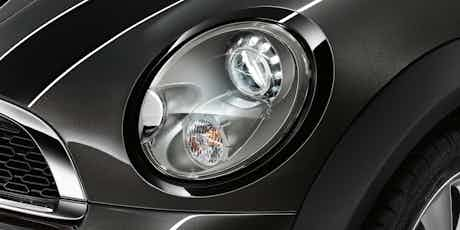What are Xenon headlights?
November 09, 2023 by carwow staff

When buying a new car, you might be confused by the various headlight options that are available on the model you want. So many different choices, but which is best?
One of those options is xenon headlights, which have become increasingly common in recent years, especially on higher-spec and premium cars. In this article, we’ll look at what xenon headlights offer, what drawbacks they suffer from and how they measure up to alternative lighting technologies.
What is a xenon headlight?
Xenon, as you might dimly remember from GCSE Science, is a chemical element (atomic number 54, if you’re counting) in the family of noble or inert gases. Like its family members (neon, for example), it’s particularly good at producing bright light. In this case… deep breath for the science bit… xenon expels short wavelength ultraviolet radiation, which becomes an intense, bright bluey-white light in contact with electricity.
In xenon headlights, the bulbs contain xenon gas (as opposed to halogen in more conventional bulbs), which emit that blueish light when switched on. Cars fitted with xenon headlights are pretty distinctive on the road, because of the bright bluey-white light, which shines up to three times brighter than halogen. The xenon gas also amplifies the brightness of the light, so it quickly reaches the temperature required to emit a high-intensity beam.
Another important difference between xenon lights and the halogen ones we’ve been using for decades, is in the function of the gas: in a xenon light, the gas is part of the production of light, as opposed to just prolonging the lifespan of the filament of a halogen bulb. Xenon bulbs use an electric arc between two electrodes, not a filament, as in a halogen bulb, to produce light. This is why they’re often referred to as high-intensity discharge (HID) lights.
You might also see bi-xenon headlights as an option for your new car. This just means that xenon bulbs are used for high beam and low beam lights, as opposed to the halogen bulb doing high-beam duties with standard xenon headlights.
What are the benefits of xenon headlights?
Having xenon headlights on your car brings three major advantages:
- Longer lifespan. Xenon headlights have a greater lifespan than those using halogen bulbs. The changing temperature of the filament in a halogen bulb makes it fragile, so it can ‘blow’ at any time. Because xenon headlights don’t have a filament, they can last a lot longer.
- Brightness. As the ‘high intensity discharge’ name implies, xenon lights are brighter than their halogen counterparts, illuminating more of the road ahead and easing driver eye strain at night.
- Safety. The distance and width of the extra light that xenon headlights emit make them perhaps the safest option. This is especially true at night, when the high-intensity beam enables drivers to spot dangers much earlier and easier than with halogen and LED lights. Drivers with xenon lights therefore have a much better view of the road, especially at higher speeds. The wider spread of light also makes them better for spotting dangers on the side of the road and when approaching bends.
Are there any drawbacks of xenon headlights?
There are also downsides to having xenon headlights:
- Cost. The xenon element isn’t abundant, so every aspect of using them is more expensive than with other options. Xenon headlights are often an extra-cost option, so you need to decide if you want to spend more money (including higher lease payments) to have them. And if you’re buying a xenon-fitted used car that’s around 10 years old, replacement units will be expensive.
-
Energy. Xenon lights are better than halogen, in terms of energy use, but xenon lights aren’t as energy efficient as the latest LED units.
Dazzling. Xenon headlights can dazzle other road users, with all the safety implications that follow. Car manufacturers use self-levelling systems to prevent the beam from pointing up too high, while some cars automatically adjust their lights to prevent dazzling oncoming traffic. - Headlight washers. Because xenon headlights are so bright, the law states that cars fitted with them must also have headlight washers. That means more of your washer fluid will splash back on the front of your car, making it dirtier, quicker.
What are the alternatives?
1. Halogen headlights
Halogen bulbs will be one of the oldest types of lighting technology that you’ll find on a new car. How they work is that halogen gas is used to help prevent the tungsten filament in the bulb blackening the surface of the glass, so the bulb stays brighter for longer.
It’s relatively cheap and easy to replace a halogen bulb in your headlights, but they’re not as energy efficient as LED or xenon lights.
2. LED headlights
An LED light is a semiconductor that emits light when a current is passed through it in one direction. It doesn’t take much current to illuminate an LED, with the energy it draws from the battery (and, as result, the engine) less than with halogen and xenon headlights.
Because LEDs are so simple, there’s little that can go wrong with them. They haven’t been fitted in cars for long enough yet, but they’re predicted to last well over a decade and their simplicity also means that they’re low in cost.
The latest clever LED headlamps can also be used to pick out the areas of the road around other traffic, lighting more of the area ahead of the driver without dazzling oncoming traffic.
Cars Change? Carwow!
Looking for a new set of wheels? With Carwow you can sell your car quickly and for a fair price – as well as find great offers on your next one. Whether you’re looking to buy a car brand new, are after something used or you want to explore car leasing options, Carwow is your one stop shop for new car deals.















